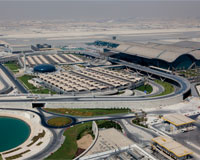HIA offers unlimited opportunities

After a decade of construction and almost four years behind schedule, the Middle East’s latest airport destination began full operations recently. Hamad International Airport in Doha, Qatar, will eventually occupy 29 square kilometers (roughly a third of the size of Doha city itself) and comes in at a total cost of $15 billion. The giant facility will have an annual capacity of 50 million passengers as well as public spaces for art exhibitions, a VIP terminal inspired by Arabian sailboats and an aquatic themed mosque. Like an increasing number of oil and gas rich cities in the region, Doha is attempting to diversify its economy to make the most of new trade and tourism opportunities. For the head of Qatar’s ambitious national carrier, the much-awaited development couldn’t have come soon enough. “It gives us unlimited opportunities,” said Akbar al Baker, CEO, Qatar Airways. Analysts say Doha, like its Gulf neighbors, understands the power and potential of aviation to provide a stable long-term industry in the region. “There’s a recognition by the (Qatari) government that aviation plays a wider economic role which doesn’t only directly support jobs,” said John Strickland, director of aviation analytics firm JLS Consulting. Dubai opened the doors of its second airport, the mammoth Dubai World Central, just last year. Such massive developments ensure competition in the region is stiff. But with so much capacity will there be enough tourism and trade to go around? That remains to be seen, but regional airlines seem convinced and are operating to ambitious expansion schedules themselves. According to the International Air Transport Association, Etihad and the other Middle Eastern carriers are currently gaining more passengers than any other region. In the first quarter of this year Dubai International Airport (a separate facility to Dubai World Central) became the busiest in the world with more than 18 million passengers, overtaking 16 million at London’s Heathrow. “The Gulf is positioned between growing markets in Asia, Africa and Latin America and the airlines who operate out of these hub airports have very long range modern aircraft. If that’s the case, all that’s left is for the Gulf carriers to grab a piece of the lucrative aviation pie in the skies. In December last year, the first Qatar Airways Cargo shipment was received at the new Hamad International Airport. The shipment for Qatar Petroleum was transferred from Europe to Doha. The new cargo terminal, which is one of the largest in the world, has the capacity to move 5,700 shipments simultaneously and to handle 1.4 million tonnes of cargo per annum by 2015, representing a 75% increase from the current airport. “Today marks a historic moment not just for Hamad International Airport but also for Qatar Airways Cargo,” said the Qatar Airways spokesperson. “The cargo terminal complex at HIA will play a significant role in expanding our global cargo business and propels Doha as the preferred cargo hub in the region, as a result of its sophisticated cargo infrastructure and capacity.” Qatar Airways added: “As one of the fastest growing economies in the world, Qatar is in a solid position to become a major international gateway. A modern, state-of-the-art infrastructure cargo is key to achieving this objective.” The new cargo terminal is built over 77,000 square metres across two levels. It comprises a separate aircraft parking apron with 11 wide-body aircraft stands, as well as 42 loading docks, a live animal centre, a dangerous goods area and a perishable storage area, making it conducive to handle large and varied cargo shipments. The landside area of the cargo terminal contains 32 truck-loading facilities to ensure the efficient transfer of cargo in and out of Qatar, with full X-ray screening systems in place to support the airport’s important focus on maximum security in the transportation of people and cargo. The terminal is also highly automated for increased cargo efficiency. HIA’s Cargo Terminal has an automated storage and retrieval system to swiftly locate and process up to 1,000 Unit Load Devices (ULDs) at a time.n




